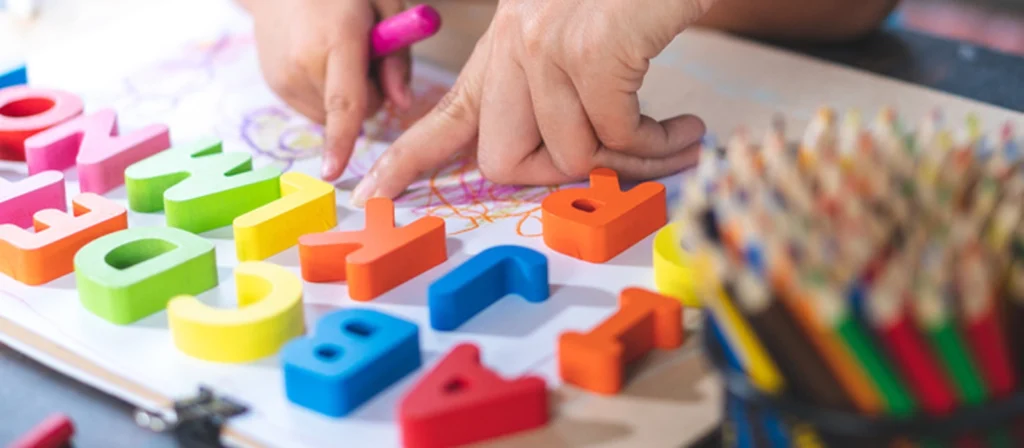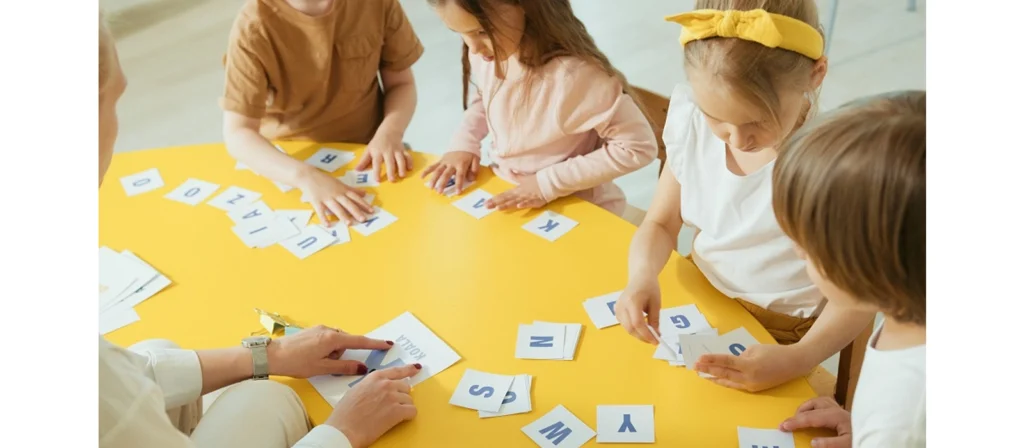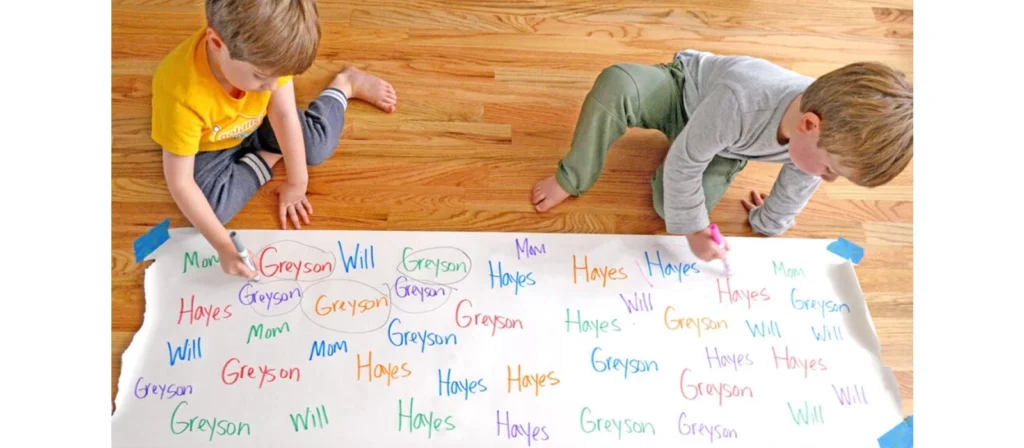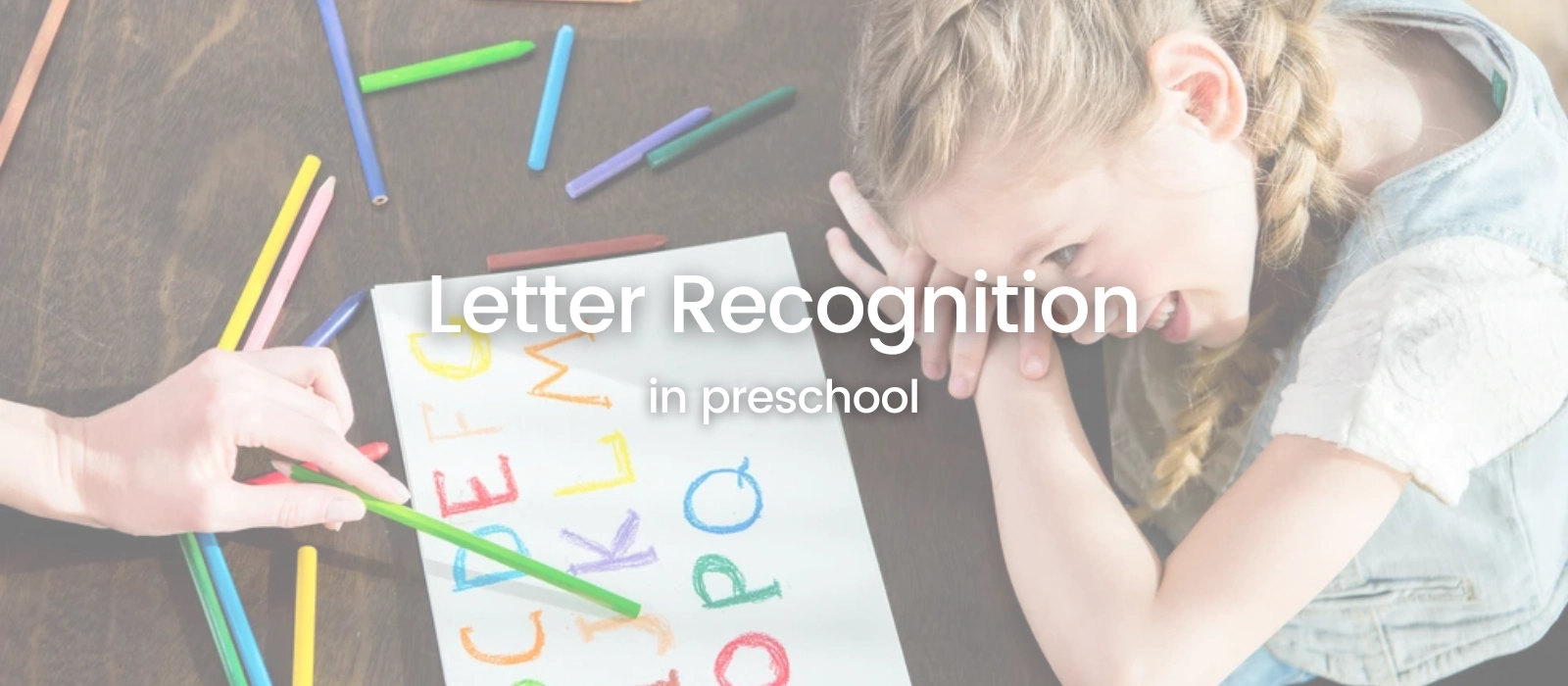Is your preschool struggling with letter recognition? Are your students mixing up similar letters like “b” and “d”? Do you find it hard to engage children with effective alphabet games? Are you unsure how to assess or improve letter recognition in a fun, measurable way?
Letter recognition is one of the most essential early literacy skills—and if it’s not built correctly, children may face reading difficulties later. Fortunately, with the right strategies, games, and printables, preschool teachers and kindergarten owners can transform letter learning into a fun, effective experience.
To help your preschool thrive, this article reveals the best letter recognition activities, games, worksheets, and teaching tips tailored for early learners. From overcoming common struggles to providing free downloadable resources, we’ve gathered everything you need to help your young students master the alphabet.
Why Letter Recognition Is So Important in Preschool
Letter recognition is the foundation of reading. Before a child can learn to read or write, they need to identify and distinguish letters by their shape, name, and associated sound. For preschool educators and kindergarten owners, ensuring this skill is well-developed is non-negotiable. Without strong letter recognition, children will struggle with word decoding, spelling, and phonemic awareness.
The importance of letter recognition extends beyond basic literacy. It directly influences early childhood development by enhancing memory, attention span, fine motor coordination, and visual discrimination. Moreover, children who master this skill early are more confident learners and are better prepared to transition into structured elementary education.
According to research, children typically begin developing letter recognition skills between ages 2 and 4, though this varies by individual development rates. Most children entering kindergarten are expected to recognize all uppercase and lowercase letters. This includes not just being able to recite the alphabet but to identify each letter in isolation, out of order, and match it to the corresponding sound—a skill known as letter-sound recognition.
For preschool owners, this skill isn’t just educational; it’s a selling point for parents. A preschool that emphasizes strong foundational skills like alphabet letter recognition often attracts more enrollments because parents see early academic success as a sign of long-term advantage.
Integrating structured letter recognition activities into your preschool curriculum also opens up access to government standards, certifications, and even funding in some countries. It reflects your commitment to evidence-based education and positions your institution as a high-quality early learning center.
For example, including alphabet letter recognition worksheets, digital apps, and games into your daily lessons can support differentiated learning styles. Children who are visual, auditory, or kinesthetic learners will all benefit from a balanced approach that includes colorful letter cards, interactive games, and printable worksheets.
With so many benefits at stake, improving letter recognition is not just a goal—it’s an essential mission. In the next section, we’ll explore the common challenges faced when teaching letter recognition and how to overcome them.

Common Challenges in Teaching Letter Recognition
Inconsistent Exposure to Letters
One of the most common issues is inconsistency in letter exposure. Children may only see letters during circle time or on posters, which is not enough for mastery. Letter recognition requires frequent, repeated, and varied exposure through multisensory activities such as tracing, singing, touching, and visual games. Without this, retention remains low.
Letter Confusion and Reversals
Another challenge is visual similarity between letters. Letters like “b,” “d,” “p,” and “q” are notoriously confusing for preschoolers, especially those who are just developing spatial awareness. Letter reversal is common and should not be punished; instead, it requires targeted intervention through hands-on games and pattern recognition exercises.
Learning Difficulties and Dyslexia
For children with learning difficulties such as dyslexia, letter recognition can be even more complex. These students benefit from highly structured phonics programs and letter-sound recognition worksheets that break learning into manageable chunks. For struggling learners, a letter recognition intervention plan may be needed, often involving one-on-one instruction or small group activities.
Short Attention Spans
Additionally, attention span is a real concern in preschool settings. Young children may not stay focused on traditional worksheets for more than a few minutes. This is why incorporating letter recognition games, songs, and interactive tools is vital to keep them engaged. For example, letter recognition games online (free and paid) offer both entertainment and skill-building.
Difficulty Measuring Progress
Educators also struggle with tracking progress. Without a clear letter recognition assessment tool, it can be hard to measure what each child knows. Teachers may find that one student knows 20 letters, while another knows only 5—but without data, it’s difficult to personalize teaching. Simple printable assessments and letter/sound recognition checklists can solve this problem.
Confusion About Teaching Order
Lastly, some teachers are uncertain about the right order to teach letters. Alphabetical order is common, but research suggests starting with frequently used letters (like “s,” “a,” “t,” “m”) may lead to better early reading outcomes. This is especially useful in phonics-based classrooms.
Understanding these common challenges allows kindergarten owners to better equip their teachers, select the right curriculum materials, and create a classroom environment where letter recognition flourishes.
In the next section, we’ll break down how to teach letter recognition effectively—including best practices, activity ideas, and expert-backed strategies.
How to Teach Letter Recognition Effectively

Use Multisensory Learning Techniques
Children learn best when multiple senses are involved. Multisensory letter recognition activities combine sight, sound, touch, and movement. For example, tracing letters in sand, forming them with playdough, or singing alphabet songs all enhance memory and engagement. Using tactile alphabet cards or finger-painting letters makes learning concrete and fun.
Teach Letters in a Logical Sequence
Instead of teaching letters in alphabetical order, consider frequency and phonetic usefulness. Many educators start with letters like “s,” “a,” “t,” “m,” and “p” because they appear often in simple words. This phonics-based approach helps children connect letter recognition with reading skills early on.
Emphasize Uppercase and Lowercase Letters
It’s important for children to recognize both uppercase and lowercase letters. Start with uppercase (which are visually simpler), then gradually introduce lowercase forms. Activities like matching uppercase and lowercase letter cards or using preschool letter recognition worksheets can help reinforce both forms simultaneously.
Incorporate Daily Letter Recognition Games
Games are essential to engagement. Use scavenger hunts, alphabet bingo, digital apps, and classroom group games. Choose age-appropriate letter recognition games for preschoolers that reinforce learning through repetition and reward. Many free printable and online games are available to support both classroom and home learning.
Use Repetition Through Daily Practice
Daily repetition is key to mastering letter recognition. Even 5–10 minutes of focused practice per day can lead to significant progress. Integrate short letter review sessions into your daily routine using flashcards, song routines, and digital activities.
In the next section, we’ll explore the most effective letter recognition activities and how to implement them at scale in your preschool classrooms.
Best Letter Recognition Activities for Preschoolers

Printable Worksheets and Flashcards
One of the easiest ways to reinforce letter learning is by using printable letter recognition worksheets and flashcards. These tools allow children to trace, color, and match letters, providing essential handwriting and visual identification practice. Alphabet letter recognition worksheets that feature both uppercase and lowercase options are especially valuable. Look for free printable letter recognition worksheets online to save on costs while offering effective material.
Interactive Letter Recognition Games
Games that involve physical activity or technology can greatly enhance engagement. Letter recognition games for preschoolers might include alphabet bingo, letter scavenger hunts, or tablet-based letter tracing apps. Online letter recognition games—many of which are free—help students learn through fun visuals, sounds, and touch-screen interaction. These games are particularly useful for visual and auditory learners.
Sensory-Based Activities
Sensory play can enhance retention by integrating tactile experience into letter recognition. Examples include:
- Writing letters in shaving cream or sand
- Using letter-shaped cookie cutters in playdough
- Making letters with Wikki Stix or pipe cleaners
These activities are perfect for 3–5 year-olds and help improve both recognition and fine motor skills.
Creative Arts and Crafts
Art-based projects are a great way to combine creativity with alphabet learning. You can:
- Create an “Alphabet Wall” with student-designed letter posters
- Make collages of objects starting with a specific letter
- Paint or stamp letters with sponge shapes
These methods encourage active participation and give children a sense of pride in their learning environment.
Alphabet Centers and Letter Bins
Setting up themed activity stations around your classroom is another great strategy. Use bins labeled with different letters and fill them with items that begin with that letter. Children can sort, explore, and discuss their findings. This reinforces vocabulary development and strengthens letter-sound associations.
Next, we’ll look at how letter sound recognition and letter identification work together in literacy development.
Letter Sound Recognition vs. Letter Identification
While often used interchangeably, letter identification and letter sound recognition are distinct concepts that work hand-in-hand in early literacy.
What Is Letter Identification?
Letter identification refers to a child’s ability to visually recognize and name letters of the alphabet. This includes both uppercase and lowercase forms and is usually the first step in reading development. Activities like matching letters, flashcards, and alphabet puzzles help reinforce this skill.
What Is Letter Sound Recognition?
Letter sound recognition is the ability to associate each letter with its corresponding phonetic sound. For example, knowing that the letter “B” makes the /b/ sound. This skill is crucial for blending and decoding words when children begin to read.
Why Both Skills Matter
Together, these skills lay the foundation for phonemic awareness. Children must not only recognize the letters they see but also understand how those letters function in spoken language. A strong grasp of both leads to greater reading fluency and spelling accuracy.
In practice, lessons should alternate between visual recognition tasks and phonics-based sound practice. For example, after identifying the letter “S,” students can sing a song about words starting with “S” or trace the letter while making the /s/ sound.
Up next, we’ll explore how to assess these skills and identify areas where children need additional support.
Assessment: How to Measure Letter Recognition Progress
Why Assessment Matters
Assessment is essential to track each child’s progress in letter recognition and to identify areas where they may need extra support. Without consistent evaluation, it’s impossible to know whether your teaching strategies are effective. Assessments can help inform instruction, provide data to parents, and guide interventions for children who are falling behind.
Types of Letter Recognition Assessments
There are several effective tools to evaluate letter identification and sound recognition:
- Letter Identification Charts – Use charts where children point to or name random letters.
- Sound Matching Tasks – Ask children to match a letter to its beginning sound.
- Flashcard Drills – Measure how many letters a child can name in 30 seconds.
- Letter Writing Tests – Assess whether children can form letters correctly by tracing or writing them from memory.
- Digital Letter Recognition Tests – Use apps that track responses and progress over time.
Using IEP Goals and Benchmarks
For children with learning difficulties, Individualized Education Plans (IEPs) often include specific goals for letter recognition and letter-sound correspondence. Example IEP goals include:
- “Student will correctly identify 20/26 uppercase letters by name with 90% accuracy.”
- “Student will identify the initial sound of spoken words for 15 consonants.”
IEP benchmarks can be tracked weekly through quick drills and printable assessment sheets. Progress can be charted to ensure the child is on target.
Printable and Digital Resources
Many websites offer free printable letter recognition assessments. These worksheets often include:
- Letter identification grids
- Lowercase/uppercase matching
- Sound-letter matching pages
- Alphabet tracing sheets
You can also use apps or websites that offer interactive digital assessments. These tools are engaging for children and provide instant feedback. Some platforms even generate progress reports to share with parents or administrators.
Best Practices for Teachers
When administering assessments:
- Keep sessions short and positive
- Offer frequent praise and encouragement
- Use one-on-one time to minimize distractions
- Record results consistently and look for trends
Regular assessment ensures children don’t fall through the cracks and provides solid data for decision-making. In the next section, we’ll explore how to help children who continue to struggle despite consistent instruction and practice.
How to Help a Child Struggling with Letter Recognition
Identify the Specific Struggles
Start by identifying what aspect of letter recognition the child finds difficult. Are they unable to name letters, confuse similar-looking ones, or struggle with associating sounds? Use a letter recognition assessment to pinpoint weaknesses and create targeted strategies. Keep in mind that some children may also have underlying learning difficulties such as dyslexia or delayed visual processing.
Break Learning into Manageable Steps
Avoid overwhelming children by introducing too many letters at once. Focus on just 1–3 letters per week and review frequently. Begin with high-utility letters such as “a,” “m,” “t,” and “s”. Use free printable letter recognition worksheets that emphasize one letter at a time through coloring, tracing, and matching games.
Use Repetition and Routine
Children who struggle with letter recognition benefit from consistent and structured routines. Daily activities such as:
- Morning alphabet songs
- Matching letter cards
- 5-minute flashcard drills
- Alphabet puzzles and tactile games All these create familiarity through repetition, helping reinforce learning over time.
Make It Multisensory
For struggling learners, multisensory instruction is key. Try:
- Writing letters in shaving cream or sand
- Building letters with playdough or LEGO bricks
- Using textured flashcards (felt, sandpaper)
- Singing songs for each letter sound These activities activate multiple parts of the brain and increase retention.
Provide One-on-One Support
Children falling behind may need extra attention in a quieter setting. Schedule short one-on-one sessions several times per week. Use focused games and letter-sound matching tasks tailored to the child’s specific gap areas. Track progress weekly and adjust the approach as needed.
Involve Parents in Practice
Consistency at home is crucial. Provide parents with free printable letter recognition games, links to letter recognition apps, and simple home activities such as letter hunts, magnetic alphabet play, and singing the ABC song. Equip families with tips on how to make practice fun and stress-free.
Celebrate Small Wins
Struggling students thrive on encouragement. Recognize even small improvements with praise, stickers, or a letter of recognition to take home. Building confidence is just as important as building skills.
Helping children who struggle with letter recognition takes time, patience, and creativity. In the next section, we’ll provide a curated list of free resources, including worksheets, printables, and letter recognition games you can use right away.

Free Resources: Worksheets, Printables, and Game Templates
Why Use Free Letter Recognition Resources
For preschools and kindergartens with limited budgets, free teaching materials are a valuable solution. Many high-quality resources are available online, covering everything from alphabet tracing sheets to full classroom games. These tools support a wide range of learning styles and allow educators to implement engaging lessons without purchasing expensive curriculum packages.
Printable Letter Recognition Worksheets
Free printable worksheets are one of the most versatile tools in a teacher’s toolkit. You can find and download:
- Alphabet tracing worksheets (uppercase and lowercase)
- Letter matching sheets
- Letter A to Z coloring pages
- Letter-sound matching exercises
- Printable letter recognition assessments These worksheets are easy to integrate into lessons and help reinforce both letter identification and sound association.
Flashcards and Alphabet Cards
Flashcards are perfect for quick practice and can be used in both group and individual settings. Look for:
- Uppercase and lowercase letter flashcards
- Phonics flashcards with images
- Printable alphabet cards with tracing dots
- Color-coded sets for vowel/consonant recognition You can laminate them for durability and use them in circle time, centers, or take-home review kits.
Free Letter Recognition Games
Printable letter recognition games make learning fun and interactive. Common formats include:
- Alphabet bingo
- Memory matching cards
- Alphabet hopscotch (letter mats on the floor)
- Letter scavenger hunts (indoor or outdoor)
- “Spin the Letter Wheel” games These resources support social learning and help reinforce letters through movement, play, and cooperation.
Online Letter Recognition Tools
Numerous websites and educational platforms provide free digital resources for letter recognition. These tools are especially useful for remote learning or tech-integrated classrooms:
- Interactive games where children drag and drop letters
- Online quizzes and assessments
- Animated songs and stories featuring letter characters
- Apps with letter tracing and sound practice Search for terms like “free letter recognition games online” or “alphabet learning apps for preschool” to find suitable options.
Templates for Custom Activities
Teachers can also download editable templates to create custom letter recognition materials. This includes:
- Blank flashcard templates
- Customizable tracing sheets
- Alphabet chart templates
- Build-your-own bingo boards These allow you to personalize content based on your students’ interests or your weekly curriculum theme.
Offering a variety of printable and digital resources helps ensure that all children have access to the tools they need to master letter recognition. In the next section, we’ll discuss what kindergarten owners should consider before investing in educational tools and furniture to support early literacy.
What Kindergarten Owners Should Know Before Purchasing Letter Recognition Tools
Prioritize Safety and Certification
Before purchasing any educational tool or letter recognition toy, make sure the product complies with safety standards. Check for certifications such as ASTM, EN71, or CE markings, especially for items made of plastic, wood, or foam. This is critical because children will often put items in their mouths or handle them roughly. Furniture and learning aids must be free of small detachable parts, sharp edges, and toxic materials.
Choose Multi-Purpose and Durable Products
Letter recognition resources should be built to last and serve more than one purpose. For example, invest in:
- Double-sided alphabet blocks (upper/lowercase + phonics)
- Tracing boards with erasable markers
- Modular alphabet wall panels
- Tables with embedded letter matching games Multi-functional products not only save money but also support different stages of early literacy development.
Match Materials to Learning Objectives
Ensure that what you’re buying aligns with your curriculum goals. For example:
- If your school uses a phonics-based approach, choose resources that pair letters with sounds.
- If you’re supporting special education needs, find tactile or visual supports for sensory learning.
- If students are preparing for standardized assessments, use worksheets that simulate test formats.
Think About Classroom Space and Storage
Every kindergarten owner knows that space is limited. Choose items that are:
- Stackable or collapsible
- Easy to sanitize
- Labeled with both letters and images Use labeled bins or cubbies to store letter games, flashcards, and puzzles efficiently. Invest in mobile carts or storage systems with drawers for organizing worksheets and printables by letter.
Evaluate Supplier Experience and Support
When sourcing letter recognition products, especially in bulk, work with suppliers who specialize in early education. Check:
- Product reviews and testimonials
- Delivery timelines and consistency
- Replacement and refund policies
- Willingness to provide samples Reliable B2B suppliers like XIHA Furniture can provide both custom designs and bulk solutions tailored to your preschool’s brand and teaching goals.
Budget for Longevity and Expansion
Don’t just buy for the current year—plan for future use. Select scalable systems that can grow with your class size. For example:
- Add-on alphabet panels
- Additional language packs (for bilingual programs)
- Modular classroom furniture with built-in literacy tools Planning long-term helps avoid constant replacement and maintains consistency in the learning environment.
Involve Teachers in the Selection Process
Ultimately, teachers will be the ones using these tools every day. Their insights are invaluable. Before making bulk purchases, ask them to test samples, suggest features, or identify gaps in the current setup.
By considering these practical factors, kindergarten owners can make informed purchases that maximize educational value and budget efficiency. In the next section, we’ll summarize additional resources and articles related to letter recognition and early literacy.
Conclusion
Letter recognition is more than just an academic milestone—it’s the foundation of early literacy and a key predictor of reading success. For preschool and kindergarten educators, implementing the right strategies, tools, and assessments can make all the difference in a child’s learning journey. Whether it’s through multisensory games, printable worksheets, structured assessments, or high-quality teaching materials, improving letter recognition in preschool is both achievable and rewarding.
At XIHA Furniture, we understand the unique needs of early education environments. That’s why we offer a wide range of preschool classroom furniture and educational resources designed to support literacy development, including letter recognition activities. Our products combine safety, durability, and functionality—ideal for creating literacy-rich learning spaces that foster both comfort and cognitive growth.
By focusing on consistent practice, early intervention, and thoughtful investment in reliable resources like those from XIHA Furniture, kindergarten owners can create classrooms where every child has the opportunity to thrive.



